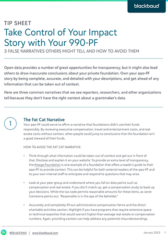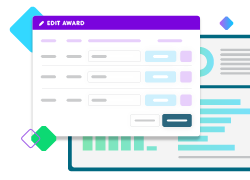Trends in Grantmaking: Don’t Leave Your Foundation’s Impact Story to Chance

If a grantmaking organization creates a funding opportunity, but there is no way for anyone to hear about it, does it make an impact?
According to Candid research, approximately 90% of foundations don’t have a website. So, when it comes to communicating your impact story, many foundations need to rely on the data in their form 990 to tell their story. Depending on the context and clarity you provide in your 990-PF, the resulting narrative might not be what you or your grantees expect.
It all starts with knowing the information you have and identifying the story you want to tell. Understanding your grantee data through clear data governance is an essential part of managing and communicating your foundation’s impact story.
Impact stories are a trend that we expect to impact grantmaking for years to come. Learn about the others in our blog post, 5 Trends in Grantmaking that We Think Have Staying Power.
Be Intentional About What Data You Collect and Where
With applications integrated directly into your grants management system and partnerships with organizations such as Candid, the days of pages-long grant applications are behind us. But you still need to collect some information in order to make an educated funding decision. The key is to be intentional.
In a conversation with Laia Griñó, who leads Candid’s Data Discovery team, she recommends putting your grantees at the center of your data governance plan. The first step is to be clear about what data you want to collect and what will help you tell the best—and most accurate—impact story. By centering your grantee’s capabilities, you are more likely to get the information to tell a clear story about how you support their work instead of asking for information they can’t or don’t have the resources to provide.
The second step is knowing the type of data you have and assessing how sensitive it is. This will help you respond quickly to any changes in security best practices or if your organization is the victim of a data breach.
When you center your grantees’ data, you also give them the opportunity to help you identify sensitive data so you can create extra safeguards for that information. While it is important to have your data set be as complete as possible to give you a full picture of your impact, don’t pressure your grantee organizations. Even if your grantee doesn’t feel comfortable sharing specific data points, generalized or anonymized data can still tell a compelling story. Just make sure grantees feel as though telling you not to store specific data will hurt their relationship.
 Free Resource
Free Resource
From Compliance to Communication
Take control of your impact story through your 990-PF with our free tip sheet

Be Complete with Your Form 990-PF
Being intentional about the data you collect on the work your grantmaking organization supports—and how you collect it—is crucial to communicating a clear impact story. One of the ways you put that data out into the world is through your 990-PF.
Your 990-PF tells a story to those who are looking through the open data. Make sure you provide the appropriate amount of context to the researchers and reporters who are combing through your tax forms, or they might come to the wrong conclusion.
Above all, make sure your form 990-PF is complete. Include the appropriate amount of data, including the names of organizations you supported—with their permission, of course. Don’t write “contact us for details” because it’s rare that the journalists or industry associations sorting through hundreds of pages of forms will take the time to do that.
In addition to being complete, be clear with how you fill out your form 990-PF. Avoid terms that are specific to your organization, such as program names. Also spell out any abbreviations so everyone understands your donation to AHR went to All Hands Raised to champion racial equity in education, and not humanitarian relief organization Atlantic Humanitarian Relief, Inc. And be as specific as possible. “Charitable donation” doesn’t help tell your story.
Remember, the audience of your 990-PF may not be familiar with your organization. They may not understand your mission or your organization’s history with your community. Provide as much context as possible in your form 990-PF, and if your organization has a website, consider posting a reader’s guide to your 990-PF to go into more detail. This can also be helpful for your internal staff and stakeholders who might get questions about your information.
Telling Your Impact Story Through Your Form 990-PF
Your 990-PF is a snapshot of the work your grantmaking organization supports. When used as a communication tool, it can help others understand the impact you are making on your focus area.
In our conversation with Janet Camarena, the Senior Director of Learning Experience at Candid, Cesar Del Valle, Director of Partnerships at Candid, and Chris Peterson from PKF O’Connor Davies, they discuss the importance of your 990-PF in telling your impact story and how you can take control of that narrative.
Understanding Your Data with Clear Reporting
Now that you have an intentional process for collecting your data, take your impact story to the next level. Use your grants management system to generate reporting that gives you clear insights into how you are affecting change. Set up dashboards in your grants management system that drill into the data you need to know so you can see your progress quickly.
Is your organization’s poor data health getting in the way of accurate reporting? Check out the white paper, How Grantmakers Can Improve Data Health and Maximize Impact, for steps on how to get the most out of your grantmaking data.
Manage your entire grantmaking workflow, from online grant applications through payments
Find out how Blackbaud Grantmaking™ fits your organization.



